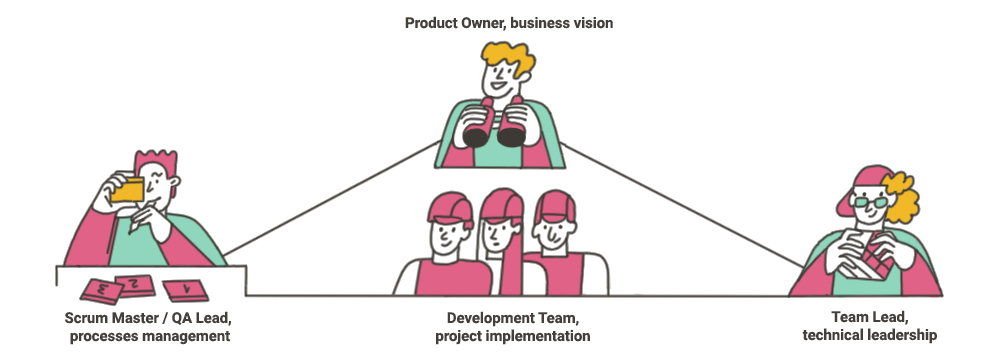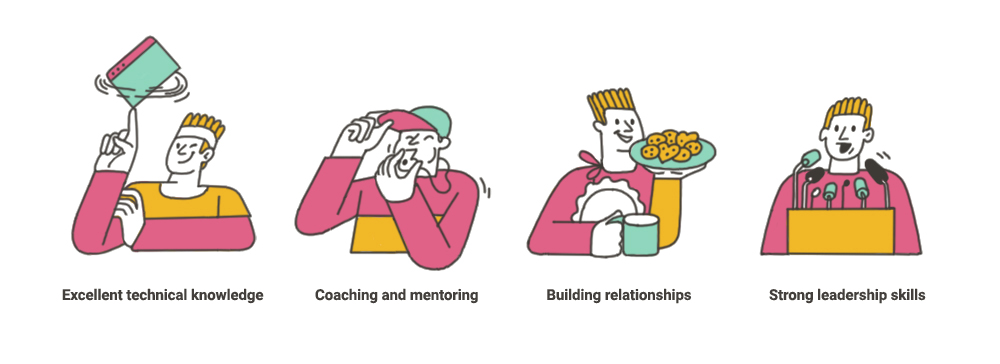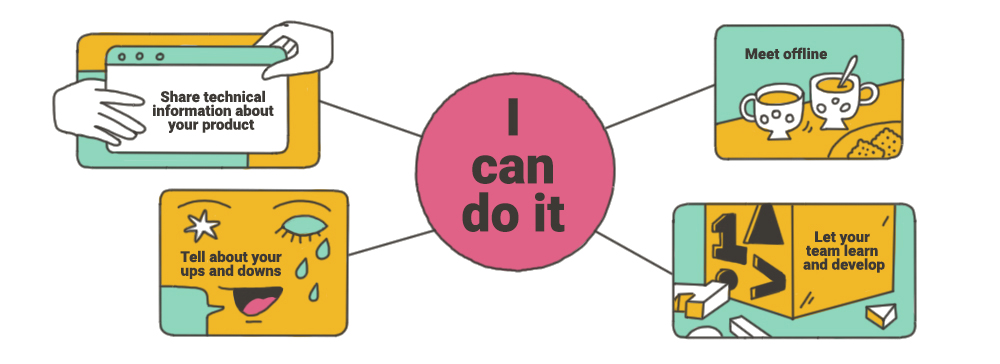- All topics
- Services
- Industries
- Opinions
- Outsourcing
- 8 min read
How to Build a Successful Software Development Team
Contents
Before diving into the guidelines for building a successful software development team, let’s figure out why you would need those in the first place. Isn’t it enough to just hire professional software engineers and call it a wrap? Actually, it’s not. Building a great team goes further than just gathering developers in one room and giving them a project to work on. A software team’s success depends on many factors: starting with the size and organizational structure ending with interpersonal communication and leadership. Here are some guidelines and best practices for running a successful team.
Software Development Team Roles and Responsibilities
Creating a project team is a challenging process. Where to start? How do you know who to hire? First of all, take three deep breaths, go fetch yourself a banana milkshake and think. What’s your objective? What tech stack will you go with? Should you start a project from scratch, which requires an architect and UX/UI designer to provide you with a solid basis of vision, wireframes, descriptions and user portraits? Will your project call for some top-notch professionalism from senior devs or can you go for enthusiastic junior developers instead? And how about the team’s size and budget? Acknowledging all the potential constraints will help you get a basic understanding of your needs.
Even after thorough thinking, the answers may not be that obvious. You need to come up with something because nobody knows your product needs better than yourself. Be sure to ask for help, and people you can trust. For instance, business partners or an outstaffing company could be able to push your train of thought in the right direction. Qualified HRs can brief you on the market conditions and recommend which technological stack offers more candidates. Tech leads will help to estimate the technological complexity of your project, figure out the number of people needed, or talk you out of using extra-complicated technologies like desktop .NET.
The methodology and structure of growing and building a software development team
Whether it is a dedicated remote team or an in-house department, the ground rules remain the same. These are your key game-changers:
- Product Owners, equipped with the best understanding of products and in-depth business insights, are indispensable when translating your vision into a technical language.
- Scrum Masters (if required) or QA leads are there to help you manage the process and make sure that everything works as it is supposed to. Here, at Beetroot, we don’t always work with a scrum framework – and sometimes team leads or QA leads can take on some of the traditional scrum masters’ responsibilities.
- Team leads and tech leads, aside from organizing and looking after the developers, checking the temperature of the team, are also armed with more than an adequate load-out of skills to lead on the technical part of the project.
- Development Team Members— this is where the magic happens; it’s your software project team. For a standard project, like creating a mobile app, you will need a UI/UX designer, two Back-end developers, one Front-end developer, and a QA.

Who should you hire first?
“Start with hiring a senior developer who can work independently,” recommends Beetroot HR consultant Anastasia Khyzhniak. “Your first senior developer can naturally turn into a team lead, helping you establish the rest of the team. So look for a person with a similar mindset so that you can entrust them with interviewing other candidates and preparing technical test tasks”.
The optimal size of a team
The best practice advises that a high performing team should consist of 6 or 7 people, and so you can consider the original Avengers team the benchmark. “A team of 6-7 people can easily interact with each other with minimal overhead coordination,” says Anastasia. “Whenever you exceed this number, communication becomes more challenging. If you need more people for your project, split them into smaller teams and assign leads for each of them”.

Should you get involved in the hiring process?
Cooperating with a trusted outstaffing partner may come with a temptation to step aside and let them do all the work. But it’s your team we’re talking about, so you should try to be as actively involved as possible. At least invest some time into talking HRs through your company needs and vision, as well as the detailed technical specifications of your project. This approach should spell out the profile of the right fit for the job.
“Another important thing to remember is the speed of communication and feedback,” says Beetroot HR consultant Tania Tanina. “The market for IT professionals is on fire, and good candidates are flying off the shelves. Whenever HRs find a decent candidate for your team, make sure you call them back within 1 or 2 days, or you risk losing them to other companies.
Team Leader Role and Responsibility in Software Development
Great teams need great leaders, right? Team leads, usually senior devs, help you manage developers and ensure that your team functions smoothly. Team leads are senior developers who have an overall understanding of the product goals, its business logic, and the technical aspects. It doesn’t take a rocket scientist to guess that they are also good communicators and usually earn a bit more. Apart from on-boarding new team members, teaching them and reviewing code, team leads ensure that everyone on a team has things to work on and will notice if the team’s spirit starts sinking.
Team lead responsibilities
A typical job description for a team lead would generally include some of these things:
- Write the best code. Team leads should set a good example for the rest of the team.
- Mentor the team. They should use coaching practices and know-how to give honest feedback, which will help motivate people to become better at their work.
- Build good relationships with everyone on a team and clients. Being a great judge of character is one of the prime responsibilities. They secure friendly relationships between colleagues and help detect toxic personalities that could undermine the team’s enthusiasm for work.

Team lead qualities
Professional team leads’ skills can vary depending on the project, but personal qualities stay the same.
“A good team lead is an honest person, who’s not afraid to give straight feedback, but, at the same time, knows how to soften harsh comments which can demotivate people,” says Anastasia. “It’s an independent and charismatic person, who is willing to teach people and encourage their professional development. Team leads take care of the emotional climate within a team, so they should be empathetic, energetic, and extraverted to some degree”.
How to Manage a Software Development Team
Now that you’ve done it and gathered a perfect team, the next step would be managing it. Here, at Beetroot, we believe that team members have the motivation and responsibility to organize their own work without having micro-managers looming over their shoulders all the time. However, for project owners, it’s important to use tools, like scrum techniques (which, in a manner of speaking, can be considered a tool) or kanban boards, to improve their teams’ performance and keep in mind some tips on leading their squad.
Communication
In a distributed team model, communication is probably the most important aspect of work. Having regular chats with your team is vital, but it’s also important to learn to trust your people. In order to avoid turning into a control freak, set up clear tasks and expectations alongside with a concrete deadline and open channels for communication. And then wait for your team to come back with the results. By doing so you will show that you believe in your teams’ professionalism and their ability to work independently.
Whenever you feel that something seems to be going awry with your team, address the problem straight away. If there is a technical issue, you should discuss it during one of the regular stand-ups. If the team’s spirit is the one lagging behind, then it’s wiser to share your concerns with HRs.
“Sometimes teams prefer to hide the internal issues from the client,” Tania says. “For instance, clients might feel that their team is feeling down, but if they ask the developers directly, the developers may say something like “everything’s fine, no worries”. For local HRs, it is easier to sense psychological tension within a team since we meet these people every day in the office. In the majority of cases, HRs can improve a team’s general mojo without involving clients. But it’s also a good practice for clients to ask HRs if there is anything that they can do to prevent such situations in the future. And generally, they indeed are able to do something. For instance, they might need to improve communication and define clear tasks and responsibilities for the team. A lot of conflicts happen when team members misinterpret clients’ tasks or have no clear understanding of their own role in the project”.
Motivation
Apart from ending every stand-up with an upbeat “great job, guys” and sending them birthday greetings, there are some other best practices to ensure that your teams’ motivation remains strong. Anastasia shares four motivation boosters to keep in mind:
- Share all the information about your product, tell your team the reasons for using these exact technologies and your perspectives on further product development. Developers need to feel that they are not mere technical resources, but a real team, which creates real value and gets feedback from users.
- Tell them about your ups and downs. Launching a new product is a rollercoaster, so let your team be a part of this process. Share your concerns and celebrate small wins with them.
- Meet offline. Organize regular meetups, workshops or just visit your team to spend some time working together. If you can’t travel that much, try sending your team branded merch: hoodies, t-shirts, or laptop stickers. It will help establish tighter bonds between you and your team, washing away the feeling of isolation and detachment.
- Let them learn and develop, by providing professional courses and encouraging them to pursue certificates or to attend conferences. In addition to that, you may want to decide on a fixed amount of time during the workday dedicated to learning some new things and growing professionally.

KPI for Software Development Teams
The best metrics of the team’s effectiveness is the quality of the code they produce. Apart from that, you can consider the time spent on work and the overall cooperation within the team.
“Planning sessions are one of the tools that can help you estimate a team’s KPIs,” Tania says. “During such sessions, the team defines the scope of tasks they plan on doing over the next week or two. Generally speaking, an efficient team is the one that accomplishes all tasks in time. If a team fails to finish all the tasks, you should organize a retrospective session and find out why this happened. On the contrary, if a team succeeds ahead of schedule, don’t rush into popping up the champagne. It might mean that their tasks were too easy or the quality of the code is not so good. Consulting a tech lead will help you understand, whether you have a super-productive team or whether or not there are issues to unpack.”

“Another way to measure team productivity is to see how they work together,” says Anastasia. If your team is friendly, open-minded, ready to cover for a colleague who may be sick, it means that you have succeeded in turning a group of people into a real unit. Their tight cooperation will have a positive impact on the quality of their work”.
***
Building a successful distributed team requires certain efforts from your side and most probably you will have to spend some extra time communicating with them and explaining your project details. However, at the end of the day, a well-built dedicated software development team can achieve remarkable results and, after all, beat most challenges that come along.










